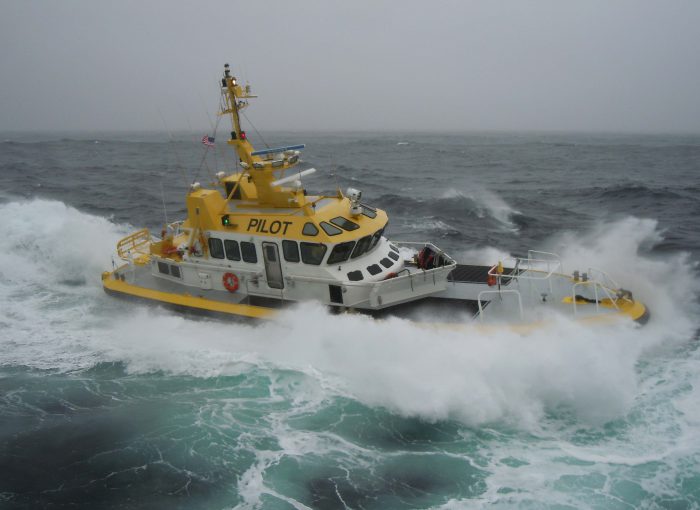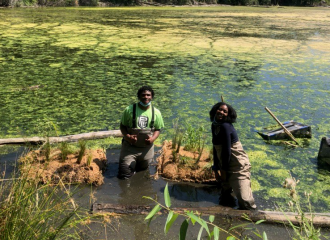Thanks to Mark Hails and the Columbia River Bar Pilots for sharing these photos and the video below.
We asked Mark Hails what it’s like to be a Columbia River Bar Pilot. From arriving to work by air and by sea to crossing the world’s most dangerous entrance to a commercial waterway, hear what he had to say and see him in action in the video below.
What’s a bar pilot?
Basically, a local marine expert. A ship’s captain is responsible for the safe navigation of his/her vessel from one port to another while in the ocean. Once the vessel has arrived at a port (where hazards are numerous and generally outside most ship master’s experience), a local pilot boards the ship. The pilot then assumes navigational conduct of the vessel, and using experience and local knowledge, safely guides it to the dock. The pilot’s intimate knowledge of the port allows for the ship to be safely maneuvered to minimize risk to the vessel while maximizing the cargo carried. For vessels calling on the Columbia River, which has a dangerous bar channel at the entrance followed by 95 miles of winding narrow river, a bar pilot boards the ship 8 to 15 miles offshore, getting there either by boat or helicopter. Pilots are responsible for guiding the largest manmade objects on the face of the earth! And, 90 percent of all goods and products produced around the world get to market by ships and vessels.
What should everyone know about the Columbia River Bar?
The Columbia River Bar is the world’s most dangerous entrance to a major commercial waterway. This is where the force of the Columbia River meets the Pacific Ocean. Conditions on the bar are extremely dynamic and can change hourly with the ability to generate huge waves. The bar pilots, through their deep and varied experience, can provide the service that allows this choke point to be safely and reliably transited to maximize the economic benefit of water transport to Northwest shippers.
How does a bar crossing work?
Before boarding a vessel, pilots access the ship’s basic information from our database or various websites. That includes length, breadth, draft (how deep it is loaded), year built, destination, etc. Then we look at the expected weather, current and traffic on the river. With this information, the pilot can plan the transit and work through any foreseen hazards to minimize them. The boarding is a large part of the job due to the hazards involved but once onboard you follow the plan built in your mind and closely monitor the progress looking for anything that deviates from that plan. Most transits are fairly routine, but the pilot is always totally focused in order to quickly recognize issues that may develop and once recognized, act on them decisively. If you face serious problems, you must seamlessly go from a shiphandler to a risk manager.
How do you determine it’s safe to cross the bar?
The Columbia River is too dynamic to have a set criterion with regards to “safe crossing.” For every ship we evaluate at least three things:
- The safety of the ship to cross.
- Our ability to get on or off safely in the ocean.
- The boat or helicopter crews’ ability to remain safe and safely return home.
As winter storms appear, we rely on our experience as pilots and previously as ship masters to make these decisions. One must analyze how a ship, which all behave a little differently, will handle in the sea, swell and wind that is forecast; allow for the errors in the forecast and the many other variables that are bound to enter the equation, and then weigh the risks and determine if the ship can safely enter or leave the river. Our organization has a long history of making these difficult decisions.
What’s the coolest part of your job?
Sorry, but I just can’t limit this answer to one item. So, here are my top three:
- Going to or from work by helicopter is a fantastic way to commute.
- During the winter, getting to experience Mother Nature in all her glory and power on a regular basis is humbling and often awe inspiring.
- Meeting and chatting with ship crews from all over the world, and often sharing a meal with them.
How did you land this job?
A lot of hard work, a love of ships and a love of being on the ocean. Just to be considered, a candidate must have an unlimited master’s license with at least two years sea time in command of an ocean-going merchant ship. I was at sea for 27 years before I submitted my application.
What do you do in your spare time?
Restoring our 1908 Foursquare home in North Portland could occupy all my spare time if I allowed. But I attempt to balance “the restoration” with gardening, woodworking, cycling and travel.





